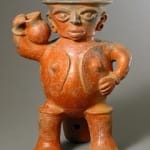Standing Effigy Figure, 300 BCE - 500 CE
Terracotta
12
PF.4288
Further images
In Meso-American culture it was customary for deformed individuals to dedicate their lives to shamanism. These special individuals were respected and held in high regard. In other words, they were...
In Meso-American culture it was customary for deformed individuals to dedicate their lives to shamanism. These special individuals were respected and held in high regard. In other words, they were considered prophets and would lead the course of the tribe. They would take hallucinogens and the result of the hallucination would decide what the tribe’s next move would be. This piece is a delightful depiction of the artistic endeavors involved in representing deformity. This artifact has immense character in its design. The body language is well defined by the pigeon chest and erect nipples. The top sections of the legs that are exceedingly wide point out from the body and are enhanced by very large feet. These feet become two of the tripod supports. The right arm is lifted up and a small vessel is placed in the curvature of the arm. The head is leaning slightly toward the vessel. The left arm loops round to the side and the hand is placed on the chest. The facial features are well defined. The eyes are wide open and alert. They are enhanced by the strong grooves that create the eyelids and brow. The nose is pronounced and aquiline. The lips are raised and the mouth is partially open. This figure is wearing a stylized mushroom shaped hat with tribal designs. Another wonderful attribute of this finely crafted work is the hunchback. Here we can see the condition of deformity of this vessel. Another special feature is the artist rendering of the buttocks. It gently rests upon the last leg of the tripod support. Beauty is in his deformity. It is something special that such a culture revered these individuals and gave them a place in their tribe of significant status.





